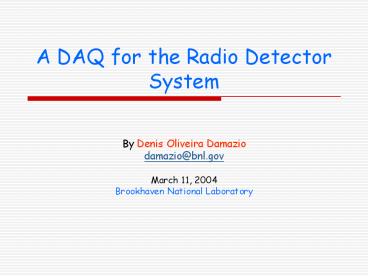A DAQ for the Radio Detector System - PowerPoint PPT Presentation
1 / 15
Title:
A DAQ for the Radio Detector System
Description:
Posix Threads are used to synchronize sound capture and recording. ... techniques developed are based in a custom software design (use of Posix threads) ... – PowerPoint PPT presentation
Number of Views:80
Avg rating:3.0/5.0
Title: A DAQ for the Radio Detector System
1
A DAQ for the Radio Detector System
- By Denis Oliveira Damazio
- damazio_at_bnl.gov
- March 11, 2004
- Brookhaven National Laboratory
2
Introduction
- Modeling the signal
- Data Acquisition System
- Practical Considerations (RTLinux, GPS)
- Offline Analysis
3
Modeling the signal
- A rough model of the signal generation can be
seen in the figure. - A Turn on/off event should be produced in the VHF
scale. - At the same time, particles would be found
between the signal generation and reception.
4
Data Acquisition System (hardware)
Yagi Antenna
Two Log-Periodic Dipole Array
5
Data Acquisition System (hardware)
- The Computer Controlled Radio Receivers are tuned
to TV VHF channels 2 and 4 (DTV). - A Sound Card (7 chs _at_ 96 KHz) acquire the
signals. - The sound is recorded in wave like format to a
fast HD. - A GPS clock sets (once a minute) the Acquisition
PC clock.
6
Data Acquisition System (software)
- Special libraries used to reduce software
development time. - The software was developed for the Linux
environment. - Posix Threads are used to synchronize sound
capture and recording. - QT Libraries for GUI design and data display.
- Online Spectrograms available (FFTW library).
- CVS repository.
7
Data Acquisition System (GPS issues)
- In order to assure correct time-stamping. A GPS
clock is used. - It is, however, impossible to assign good clock
to a PC (error of the order of seconds). - Inclusion of GPS as an extra DAQ channel treated
separately. - GPS signal not completely recorded.
8
Data Acquisition System (RT issues)
- Looking more precisely into 2003 data, gaps could
be easily spotted in data (thanks to the GPS
signal). - Different operating systems were tried (RTLinux
GPL, different Linux kernel versions and
low-latency patches). - A combination of OS resources, buffering and
software redesign (priorities avoid SysCall)
solved the problem.
9
Usage of the Sound Card in the bottle experiment
- Instead of using a complex electronics to detect
coincidences in the bottle experiment, one can
feed their signal directly to the sound card. - Together with the GPS, a nice and very cheap
measurement system can be built.
10
Usage of the Sound Card in the bottle experiment
- The coincidence of the signals can be easily
spotted. - A simple shaping circuit can improve the signal
resolution and peak detection. - A small LapTop could be used to record GPS sum
of bottles signals.
11
Offline Analysis
- The offline analysis chain is adaptive to couple
with the varying background. - The detection is performed by a simple two level
peak algorithm.
12
Some Results
- These are the results for some recording days.
- More results to come with the RTGPS improvement.
13
Conclusions
- A data acquisition system for the Cosmic Rays
Radio Detector System is presented. - So far the emphasis has been in data quality
issues (signal model, time-stamping, continuity
of data acquisition). - In terms of hardware, the system is based on
Antennas, simple Radio Receivers and a special
sound card. A GPS is used for time refference.
14
Conclusions
- The techniques developed are based in a custom
software design (use of Posix threads) together
with an adequate OS choice to ensure IRQ handling
in a deterministic time interval. - The software design is general enough to be used
in other fields (for example, bottle or
scintillation counters DAQ).
15
Conclusions
- An offline detection procedure based in adaptive
algorithms was implemented - The offline analysis taken so far showed the
sensibility of the technique to meteor ionization
clouds. - Other techniques are being envisaged (matched
filter, wavelets, NN). Any other suggestions?! - A web page for this part of the work can be found
in http//www2.bnl.gov/damazio/log































